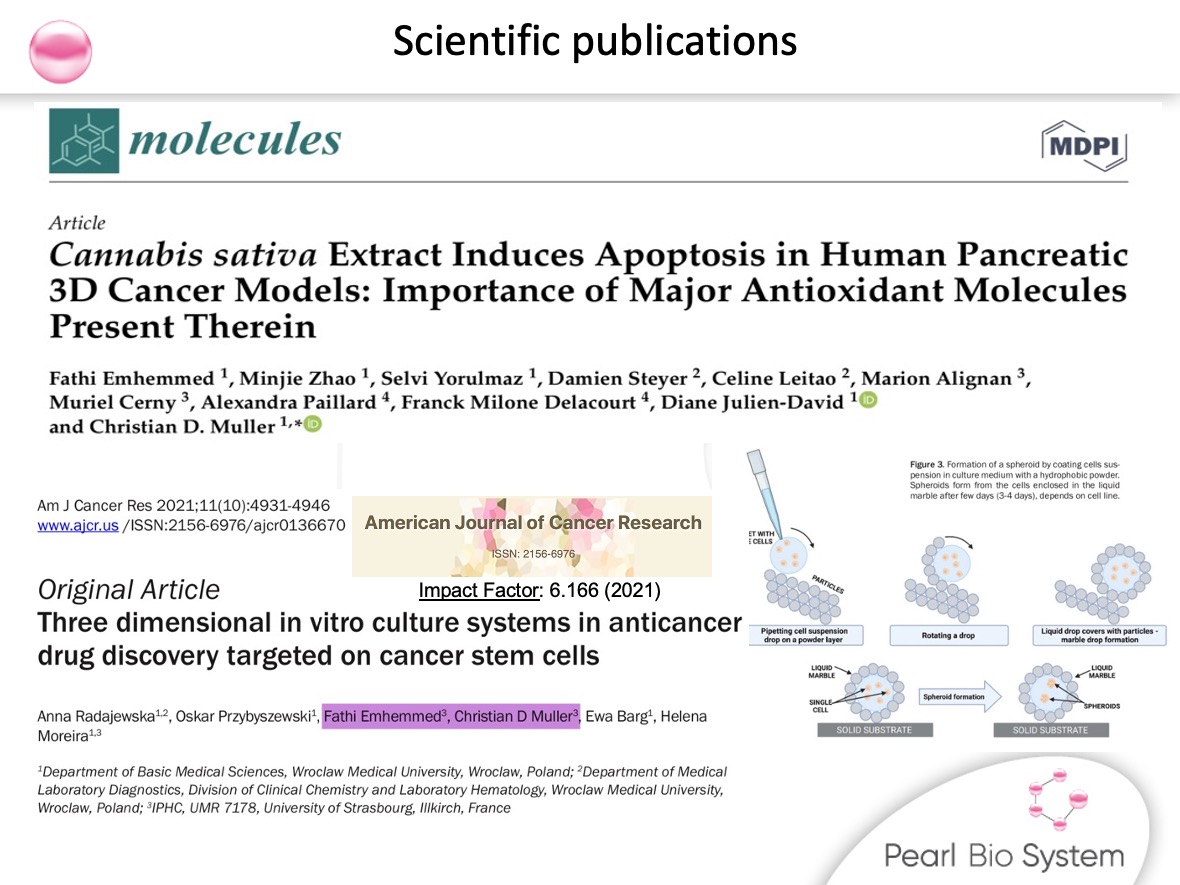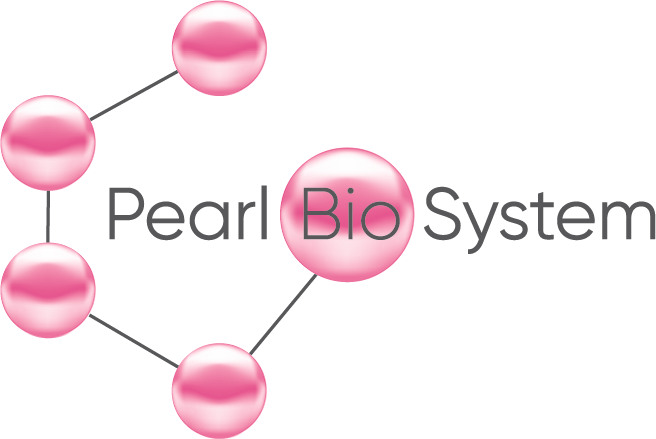Publications
Cannabis sativa Extract Induces Apoptosis in Human Pancreatic 3D Cancer Models: Importance of Major Antioxidant Molecules Present Therein
https://www.mdpi.com/article/10.3390/molecules27041214
In recent years, interest in Cannabis sativa L. has been rising, as legislation is moving in the right direction. In this report, the objectives were: (i) to compare three different cannabinoid extraction methods; (ii) to identify and quantify the compounds exhibiting anticancer activity on human pancreatic cells; and (iii) to study the mechanism of action for apoptosis induction in a pancreatic cancer line described for drug resistance. Such a mechanistic study was never performed with human pancreatic chemo-resistant cancer organoids generated in Liquid Pearls: to use of an original 3D culture model was a crucial first step in this study. It helped to validate the efficacy of the extract in a test as close as possible to an in vivo animal model. Such a testing had to be performed, prior to any other experiment, to avoid any false positive responses often obtained in 2D flat biology. While gemcitabine, a gold standard drug in the treatment of pancreatic cancer, only triggers cell cycle arrest in G0/G1, the cannabinoid extract also activates the cell signaling cascade leading to programmed cell death. The results reported therein emphasize the potential of natural products issued from medicinal hemp for pancreatic cancer therapy, as they lead to an accumulation of intracellular superoxide ions, affect the mitochondrial membrane potential, induce G1 cell cycle arrest, and ultimately drive the pancreatic cancer cell to lethal apoptosis
Three-dimensional in vitro culture systems in anticancer drug discovery targeted on cancer stem cells
Am J Cancer Res 2021;11(10):4931-4946
https://e-century.us/files/ajcr/11/10/ajcr0136670.pdf
Cell cultures remain an important element of any research of new drug discovery as well as cell signaling pathways studies. The 2D culture methods used so far have many limitations. As such, the various 3D culture techniques have a good chance of supplanting single-layer cultures. Three-dimensional cultures have many advantages, however, still require some improvements. Firstly, the cost of such cultures exceeds the cost of traditional ones. Specific scaffolds, hydrogels, plates, or even the appropriate medium used for organoid cultivation significantly increase the final expense. Another problem seems to be the amount of work needed to create such a system. Some methods require manual pipetting of small volumes of fluids. However, improvement of this methods is observed. Nowadays, more and more companies provide modifications, that allow investigators to cultivate spheroids on the high-throughput systems. Supplying growing spheroids with nutrients is an additional challenge, which has been partly solved in the case of microflows cultivation. The later stage of 3D culture research, i.e., their evaluation and imaging, is also becoming important. Flow cytometry, used especially in CSC studies, is associated with the termination of the culture, as it requires enzymatic destruction of the 3D structure. Thus, image cytometry is a solution, which now brings the question of accessibility of the markers inside the spheroid structure. Liquid pearls are transparent and have the same properties as a liquid drop and also behave as a soft solid. Unquestionably 3D cultures in CSCs research provide much greater opportunities and better reflect their phenotype or mechanisms for stimulating tumor formation. It remains necessary to further develop and improve the current culture techniques so that 3D cultures can be an easy model for preclinical research on precursor cells in targeted cancer therapy. With further development of 3D cultures, it will be possible to eliminate certain drugs and/or modify them already at the initial screenings what can significantly reduce the time and cost of anti- cancer research.

Oncology Publications
Recent Publications authored by the Pearl Biosytem scientists related to cancer research
Abid, F.; Saleem, M.; Muller, C.D.; Asim, M.; Arshad, S.; Maqbool, T.; Hadi, F.,
Anti-Proliferative and Apoptosis-Inducing Activity of Acacia Modesta and Opuntia Monocantha Extracts on HeLa Cells. Asian Pacific Journal of Cancer Prevention 2020, 21, (10), 3125-3131.
https://doi:10.31557/APJCP.2020.21.10.3125
Ben Ayache, S.; Behija Saafi, E.; Emhemmed, F.; Flamini, G.; Achour, L.; Muller, C. D.,
Biological Activities of Aqueous Extracts from Carob Plant (Ceratonia siliqua L.) by Antioxidant, Analgesic and Proapoptotic Properties Evaluation.
Molecules 2020, 25, (14), 3120.
https://doi:10.3390/molecules25143120
Filipović, N. R.; Bjelogrlić, S. K.; Pelliccia, S.; Jovanović, V. B.; Kojić, M.; Senćanski, M.; La Regina, G.; Silvestri, R.; Muller, C. D.; Todorović, T. R.,
Selenotriapine – An isostere of the most studied thiosemicarbazone with pronounced pro-apoptotic activity, low toxicity and ability to challenge phenotype reprogramming of 3-D mammary adenocarcinoma tumors.
Arabian Journal of Chemistry 2020, 13, (1), 1466-1489.
https://doi.org/10.1016/j.arabjc.2017.11.017
Ahmad, T.; Ashraf, W.; Ibrahim, A.; Zaayter, L.; Muller, C.D.; Hamiche, A.; Mély, Y.; Bronner, C.; Mousli, M.;
TIP60 governs the auto‑ubiquitination of UHRF1 through USP7 dissociation from the UHRF1/USP7 complex,
International journal of oncology, 2021, 59,5,1-17.
https://doi.org/10.3892/ijo.2021.5269
Radajewska, A.; Przybyszewski, O.; Emhemmed, F.; Muller, C.D; Barg, E. Moreira, H.;
Three dimensional in vitro culture systems in anticancer drug discovery targeted on cancer stem cells,
American Journal of Cancer Research, 2021 11, 10, 4931-4946.
https://www.ncbi.nlm.nih.gov/pmc/articles/PMC8569359/pdf/ajcr0011-4931.pdf
Ashraf, W.; Ahmad, T.; Almalki, N. AR; Krifa, M.; Zaayter, L.; Pizzi, A.; Muller, C.D; Hamiche, A.; Mély, Y.; Bronner, C.;
Tannin extract from maritime pine bark exhibits anticancer properties by targeting the epigenetic UHRF1/DNMT1 tandem leading to the re-expression of TP73,
Food & Function, 2022 13,1,316-326.
https://doi.org/10.1039/D1FO01484F
Moreira, H.; Szyjka, A.; Grzesik, J.; Pelc, K.; Żuk, M.; Kulma, A.; Emhemmed, F.; Muller, C.D; Gąsiorowski, K.; Barg,E.;
Celastrol and Resveratrol Modulate SIRT Genes Expression and Exert Anticancer Activity in Colon Cancer Cells and Cancer Stem-like Cells,
Cancers, 2022, 14,6,1372.
https://doi.org/10.3390/cancers14061372
Emhemmed, F.; Zhao, M.; Yorulmaz, S.; Steyer, D.; Leitao, C.; Alignan, M.; Cerny, M.; Paillard, A.; Delacourt, F. M.; Julien-David, D.; Muller, C. D.,
Cannabis sativa Extract Induces Apoptosis in Human Pancreatic 3D Cancer Models: Importance of Major Antioxidant Molecules Present Therein.
Molecules 2022, 27, (4), 1214.
https://doi.org/10.3390/molecules27041214
Thiam, K.; Zhao, M.; Marchioni, E.; Muller, C.D.; Diop, Y.M.; Julien-David, D.; Emhemmed, F.
Cytotoxic and Pro-Apoptotic Effects of Leaves Extract of Antiaris africana Engler (Moraceae).
Molecules 2022, 27, 7723.
https://doi.org/10.3390/molecules27227723
Simo, L.M., Messi, L.M., Mbing, J.N., Muller, C.D., Boyom, F.F., Begoudé, A.D.B., Pegnyemb, D.E., Haddad, M. and Noté, O.P.,
A New Triterpenoid Saponin from Albizia zygia Induced Apoptosis by Reduction of Mitochondrial Potential Status in Malignant Melanoma Cells.
Planta medica 2023. 89(01): 86-98
https://doi.org/10.1055/a-1806-2692
